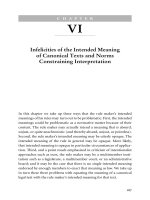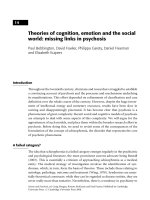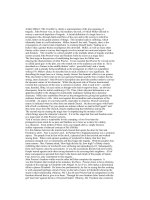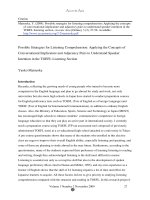Infelicities of the Intended Meaning of Canonical Texts and Norms Constraining Interpretation
Bạn đang xem bản rút gọn của tài liệu. Xem và tải ngay bản đầy đủ của tài liệu tại đây (162.22 KB, 24 trang )
P1: KNP Top Margin: 0.50186in Gutter Margin: 0.94101in
c06 cuus142 ISBN: 978 0 521 70395 6 March 23, 2008 11:24
CHAPTER
VI
Infelicities of the Intended Meaning
of Canonical Texts and Norms
Constraining Interpretation
In this chapter we take up three ways that the rule maker’s intended
meanings of his rules may turn out to be problematic. First, the intended
meanings could be problematic as a normative matter because of their
content. The rule maker may actually intend a meaning that is absurd,
unjust, or quite anachronistic (and thereby absurd, unjust, or pointless).
Second, the rule maker’s intended meaning may be utterly opaque. The
intended meaning of the rule in general may be opaque. More likely,
that intended meaning is opaque in particular circumstances of applica-
tion. Third, and a point much emphasized in criticism of intentionalist
approaches such as ours, the rule maker may be a multimember insti-
tution such as a legislature, a multimember court, or an administrative
board; and it may be the case that there is no single intended meaning
endorsed by enough members to enact that meaning as law. We take up
in turn these three problems with equating the meaning of a canonical
legal text with the rule maker’s intended meaning for that text.
167
P1: KNP Top Margin: 0.50186in Gutter Margin: 0.94101in
c06 cuus142 ISBN: 978 0 521 70395 6 March 23, 2008 11:24
168
REASONING FROM CANONICAL LEGAL TEXTS
I. Absurd, Unjust, and Pointless Intended Meanings
Thereisnodoubtthat,onoccasions,eventhebestrulemakerwill
promulgate a canonical legal text, the intended meaning of which will
be absurd, unjust, or pointless. This is not an embarrassment for our
position on interpretation of canonical legal texts – far from it. Only if one
eliminates all vestiges of formalism within law – which we would equate
with eliminating law itself – and reduces the meaning of all humanly
posited legal rules to the Spike Lee injunction, “Do the right thing,” can
one escape the possibility of laws that properly interpreted are absurd,
unjust, or pointless. And even applying the Spike Lee injunction will,
given human fallibility, often lead to doing the wrong thing, thus creating
a conflict between the master rule – “Do the right thing” – and the rules
that implement it. If the latter are “interpreted” as “Do the right thing,”
settlement of what to do can never occur. Doing “the right thing” will
inevitably lead to doing the wrong thing. On the other hand, settlement
inevitably will result in some moral errors – some cases of absurd, unjust,
or pointless rules. Our view is no more vulnerable to these problems than
any view that sees law as settling moral controversies – that is, any view
that characterizes law as positivistic, at least in part.
Indeed, on our view, proper interpretation – recovery of the rule
maker’s intended meaning of his text – will lead to absurd, unjust,
or pointless results less often than would certain other recommended
approaches to interpreting legal texts, especially strict textualism. (We
take up this point in the following chapter.) For the fact that ascrib-
ing a particular meaning to a legal text would make that text absurd,
unjust, or pointless is strong evidence that the rule maker did not intend
that meaning.
There are numerous real life examples of instances where what at
first looks like an absurd or unjust result was clearly not the intended
meaning of the rule maker. In Cernauskas v. Fletcher,
1
the case in which
a party cited a recently enacted law that by its terms repealed “all laws
previously enacted” to argue that the law relied on by the other party
was repealed, it was clear to the interpreting court that the Arkansas
1
21 Ark. 678, 201 S.W. 2d 999 (1947).
P1: KNP Top Margin: 0.50186in Gutter Margin: 0.94101in
c06 cuus142 ISBN: 978 0 521 70395 6 March 23, 2008 11:24
INFELICITIES OF THE INTENDED MEANING
169
legislature’s intended meaning was not the repeal of the entire corpus
juris, an absurd and surely unjust result. And it is abundantly clear that
despite its punctuation, the Seventeenth Amendment was intended to
apply indefinitely rather than for only six years.
2
And it is arguable that
in the Holy Trinity case,
3
the Supreme Court reached the right result in
finding that Congress’s intended meaning in proscribing bringing foreign
laborers into the United States did not encompass religious ministers.
(We are assuming for purposes of argument, and in line with the Court’s
majority, that excluding ministers would have been seen at the time to
be a policy error.)
Nonetheless, at times even the best of rule makers will make an
error in terms of assessing the present facts, forecasting future facts, or
weighing moral considerations. Take another frequently mentioned case,
United States v. Locke.
4
In that case a litigant filed a claim on December
31 under a statute that required such claims to be filed “before December
31.” The litigant argued that Congress undoubtedly meant “on or before
December 31,” as there was no conceivable reason for it to have chosen
December 30 rather than December 31 as the last day to file. Nonetheless,
the Court rejected the litigant’s argument and held the claim not timely
filed. The Court may have erred in terms of Congress’s intended meaning,
as the losing party contended. On the other hand, Congress’s intended
meaning may have been to require filings by December 30, although,
if confronted with this issue, Congress might have admitted that it was
pointless or wrong for it to have so intended.
Or, to take our hypothetical “no bears” rule from the preceding
chapter, it may be the case that the rule maker did not realize that
pandas were completely harmless; had he realized that, he would have
exempted them from his rule. Nonetheless, he might say that although
he intended to include pandas within his rule, he was mistaken to have
done so. That is, his “no bears” rule, which was intended to include
pandas, is inferior to a “no bears except pandas” rule. The rule maker
erred by intending to include pandas. (This type of error – the infelicitous
2
See U.S. Const. amend. XVII: “The Senate of the United States shall be composed of two
Senators from each state, elected by the people thereof, for six years. . . .”
3
Church of the Holy Trinity v. United States, 143 U.S. 457 (1892).
4
471 U.S. 84, 93–96 (1985).
P1: KNP Top Margin: 0.50186in Gutter Margin: 0.94101in
c06 cuus142 ISBN: 978 0 521 70395 6 March 23, 2008 11:24
170
REASONING FROM CANONICAL LEGAL TEXTS
but intended rule – is different from a felicitous intended rule that has
infelicitous applications; for, as we have stressed throughout, almost any
rule will have some infelicitous applications or omissions that cannot be
eliminated without undermining the value of the rule qua rule.)
5
Infelicities – absurd, unjust, or pointless rules – are ineliminable,
given human fallibility. Equating the proper interpretation of canonical
legal texts with the intended meaning of the authors of those texts – the
rule makers – surely leaves the door open to interpretations that result
in absurdity and injustice. Ultimately, however, as we have consistently
argued, given the settlement function of canonical legal texts, the possi-
bility of such substantive infelicities is not a point against our approach
to interpretation but a point in its favor.
II. Opaque Intended Meanings
Searching for the rule maker’s intended meaning may reveal another type
of infelicity. As we argued in the preceding chapter, there will be occasions
when even the rule maker himself will not be sure what meaning he
intended. We gave the example of a newly discovered species of bear that
is tiny and docile, and we said that the rule maker might himself be quite
uncertain whether he did or did not intend to include such a species
in his “no bears” rule. When the interpreter comes to a case where the
rule maker’s intent is indeterminate to everyone, including even the rule
maker, interpretation of the rule by reference to its author’s intended
meaning yields no answer. In a sense, the rule does not cover the case,
either to include it within the rule’s application or to exclude it.
When the rule maker’s intended meaning is opaque in this way, what
should the interpreter do? One thing is clear: whatever the interpreter
does to resolve the case, it will not be through interpretation. Beyond
that, there are essentially two options, depending on the authority of the
interpreter. If the interpreter has lawmaking authority, she can construct
a rule to cover the case, presumably one that is normatively attractive
5
Thus, if the “no bears except pandas” rule resulted in too many errors in its application relative
to the “no bears” rule – perhaps because too many nonpandas would be taken for pandas –
the latter might be the better rule despite pandas’ not coming within its rationale.
P1: KNP Top Margin: 0.50186in Gutter Margin: 0.94101in
c06 cuus142 ISBN: 978 0 521 70395 6 March 23, 2008 11:24
INFELICITIES OF THE INTENDED MEANING
171
when conjoined with the remainder of the primary rule maker’s rule. If
the interpreter has no lawmaking authority, then the case is governed
by status quo ante legal rules. If the “no bears” rule were a prohibitory
exception to a general permission to keep animals near private resi-
dences, the case of the questionable “bear” should be resolved in favor of
a permission.
III. Conflicting Multiple Intended Meanings
Perhaps one of the most frequent criticisms of intentionalist theories
of legal interpretation such as ours is that they cannot be applied to
multimember rule-making bodies such as legislatures, administrative
boards, and appellate courts. Individuals have states of mind such as
intentions; groups do not. So goes the critical refrain.
We agree that groups do not have states of mind qua groups. And
we do not posit the existence of group intentions beyond the intended
meanings of the individuals who compose the group. Nor do we deny
that those individual intended meanings can differ from person to person
within the group and can in some cases conflict. Finally, we do not deny
that these facts will create difficulties for intentionalist interpretation
in some cases. What we do deny is that such difficulties should cause
us to reject intentionalism. Instead, what they suggest is that, on some
occasions, what appears to be a meaningful law (because its text seems
to parse) is actually meaningless.
To begin with, in many cases, the rule makers who possess the author-
ity to create a binding legal rule – say, the legislators necessary to pass a
law (usually a majority of the legislature, but occasionally a supermajor-
ity)–willallintendthesamemeaningfortheruletheyenact.Inother
words, over the range of real or hypothetical applications of the rule,
felicitous and infelicitous, if asked how the rule was intended to apply,
each member of the majority sufficient to pass the rule would give the
very same answer.
In a large number of other cases, individual members of the majority
would agree in terms of intended meaning in most real and hypotheti-
cal applications but would disagree about a few such applications. In the
cases of disagreement, there is no univocal intended meaning. But so long
P1: KNP Top Margin: 0.50186in Gutter Margin: 0.94101in
c06 cuus142 ISBN: 978 0 521 70395 6 March 23, 2008 11:24
172
REASONING FROM CANONICAL LEGAL TEXTS
as enough rule makers for passage would have voted for the rule even
if it did not apply in the area of disagreement, the core area of overlap-
ping intended meanings is the enacted rule, and the fringes without the
backing of sufficient overlapping intended meanings are not within
the rule.
To illustrate this possibility, suppose that groups A and B make up a
majority of the legislature, and they enact a rule that A intends to outlaw
X and Y and B intends to outlaw X and Z. If neither A nor B is of sufficient
size to constitute a majority of those voting aye, but both A and B would
approve of a rule outlawing only X (and not Y or Z), then the rule has a
core meaning, namely, that of outlawing X.
In both of the preceding examples, the multimember character of the
rule maker does not defeat the attribution of an intended meaning for
the rule, though in the second example the rule is more truncated than
many intended. However, a third type of example raises real problems
for intentionalism. Imagine that the legislative body that enacts the “no
bears” rule is comprised of three legislators, A, B, and C. C voted against
the “no bears” rule on the ground that it devalued liberty and property
relative to physicalsecurity. A and B voted for it. A believed that pandas are
bears and intended the rule to cover them. Had pandas been excepted,
A would have voted against the rule as unfair to owners of declawed,
defanged, friendly black bears. On the other hand, B believed the rule
did not cover pandas, pandas not falling within his intended meaning
of “bears.” Had B believed pandas were included, he would have voted
against the rule. (“Who could be so cold or unreasonably fearful as to
ban the cute and gentle panda?”) A and B did not clarify whether pandas
were within the rule before voting.
The results of this disagreement are these. The rule “no bears” admits
of two relevant possible meanings: “No bears, including pandas, are
allowed” and “No bears, except pandas, are allowed.” Although the “no
bears” rule itself passed two to one, each of its possible meanings would
have been rejected by two-to-one votes. The “no bears” rule has no
core of intended meaning that would have been supported by enough
legislators for enactment. Neither legislator has been granted authority
by the community to settle by herself what the rule should be.
On our view, the “no bears” rule is only apparently meaningful
but not actually so. It is no different from the case where a term in a
rule is ambiguous and has two nonoverlapping definitions, and some
P1: KNP Top Margin: 0.50186in Gutter Margin: 0.94101in
c06 cuus142 ISBN: 978 0 521 70395 6 March 23, 2008 11:24
INFELICITIES OF THE INTENDED MEANING
173
legislators intend one meaning and the others intend the alternative
meaning. (Consider: “No canards are allowed in the park,” where C
votes against the rule on libertarian grounds; A votes for it intending
one meaning for “canards” – ducks; and B votes for it intending another
meaning – lies. The rule can only mean either “no ducks” or “no lies,”
and neither meaning has the backing of a majority.)
If we assume that only the intended meaning of a legislative majority
regarding what law subjects are obligated to do is authoritative for those
subjects, then in these kinds of cases, an apparently meaningful rule is in
reality no more meaningful than potential signs produced accidentally –
that is, without any intention to signify anything. Monkeys on typewrit-
ers, cloud formations, and spilled ink may make what might appear to
be words in some natural language. But if the monkeys, the clouds, or
the spilled ink produced the shapes c, a, t, it would be odd to ask if that
means a tabby, any feline, or a jazz musician. Although it could mean
any of those – indeed, it could mean almost anything given infinite pos-
sible languages with infinite possible ways to signify meanings – without
the backing of someone’s intended meanings, those unintended shapes
have no meaning at all. They are evidence of natural processes, but they
are not bearers of meaning.
Our pathological account of the “no bears” rule renders it no different
from the natural products of typing monkeys, clouds, and spilled ink.
Once we know the intended meanings of A and B, it is a category mistake
to ask what the rule means. A’s own rule is meaningful, as is B’s; but their
jointly produced rule is not.
IV. Norms Constraining Intended Meanings as Antidotes to the
Foregoing Infelicities
A
.
SUBSTANTIVE CONSTRAINTS
1. Norms for Avoiding Substantively Infelicitous Results
Substantive constraints on rule makers’ determinations, although quite
important practically, are relatively unproblematic jurisprudentially. We
are used to the idea of substantive constitutional constraints on legisla-
tive, executive, and judicial acts. And as we point out in Chapter 8,there
is nothing fundamentally different about substantive preconstitutional
P1: KNP Top Margin: 0.50186in Gutter Margin: 0.94101in
c06 cuus142 ISBN: 978 0 521 70395 6 March 23, 2008 11:24
174
REASONING FROM CANONICAL LEGAL TEXTS
constraints on the authors of constitutions, that is, constraints assumed
by the populace in its acceptance of the authority of those authors. For
example, as a preconstitutional matter, we could accept a norm that estab-
lishes as fundamental law the determinations of the 1787 constitutional
framers, except to the extent that those determinations are substantively
absurd, unjust, and so on.
Substantive constraints such as one denying the authority of any legal
rule that is absurd or grossly unjust (by the interpreter’s standards) are
different from epistemological principles that help interpreters discover
what the legal rule makers intended ought to be done. That some result
would be absurd or grossly unjust can be evidence – often strong evi-
dence – that the rule makers did not intend that result. Nonetheless, as
we have stressed, rule makers can intend absurd or unjust results, even if
not under those descriptions. That is, it is possible that: (1) rule makers
wish to require only what is just and not absurd; (2) rule makers intend
that X be done; and (3) X is unjust or absurd. Simply put, rule makers can
intend unjust or absurd results because they make mistakes. And a norm
that directs interpreters to disregard intended absurd or unjust results
operates as a constraint on the rule makers’ power to determine author-
itatively what ought to be done rather than as an aid to understanding
what the rule makers did in fact determine.
Substantive constraints on the rule makers’ determinations can func-
tion as absolute limits, much as do ordinary constitutional norms that
limit the authority of governmental actors. Alternatively, they can func-
tion as do artificial evidentiary presumptions by directing interpreters
to resolve uncertainties about the rule makers’ intentions in favor of
certain outcomes. Thus, if the rule makers’ intentions are not clear, such
substantive norms might direct interpreters to resolve the ambiguity in
favor of the result that seems most just or wisest, rather than in favor
of the result best supported by the evidence regarding the rule makers’
intentions, which evidence includes the fact that one result is more just
or wiser than the other.
6
6
Cass Sunstein’s canons of statutory interpretation appear to function as substantively moti-
vated, evidentiary presumptions rather than as either norms that define what legislation
“means” or norms that act as absolute limits on the authority of that meaning. Cass R. Sun-
stein, Interpreting Statutes in the Regulatory State, 103 Harv. L. Rev. 405 (1964). For Sunstein
urges the following canons unless it is clear that the statute “means” something at odds with the
P1: KNP Top Margin: 0.50186in Gutter Margin: 0.94101in
c06 cuus142 ISBN: 978 0 521 70395 6 March 23, 2008 11:24
INFELICITIES OF THE INTENDED MEANING
175
Both types of substantive constraints, however, must be the prod-
uct of a decision-making body that possesses higher authority than the
rule maker thereby constrained. That is so because both absolute and
presumptive constraints on a rule maker result in departures from that
rule maker’s intended meaning and thus depart from that rule maker’s
determination regarding what ought to be done.
7
And the norms that
are the product of this higher-authority decision-making body – be it
a constitutional ratifying body or ultimately, insofar as the substantive
norms are preconstitutional norms on which the constitutional norms
ultimately rest, the citizens who accept the norms – must mean what
their authors intended them to mean, whether the authors are the con-
stitutional ratifying bodies or the people themselves “authoring” norms
by accepting them.
2. Norms for Effectuating Specific Policies
The common law is replete with doctrines that direct judges to disregard
the intended meanings of documents that are otherwise thought to be
canonical statements regarding parties’ legal rights and duties. These
include the parole evidence rule for the interpretation of contracts, the
doctrine that an ambiguous contract shall be construed against the party
who drafted it, presumptions against disinheritance, and many others.
In effect, these doctrines direct judges to imagine a hypothetical author
who is different from the actual author and to ask what meaning the
hypothetical author would have intended in drafting the document. If the
hypothetical author’s intended meaning differs from the actual author’s
meaning, the former meaning controls. In this way, the common law
makes it more difficult, though not impossible, for actual authors to take
advantage of contractual partners, to assert an idiosyncratic intended
meaning that would deny the existence of a “meeting of the minds,”
canons. See, e.g., id. at 423, 434, 450, 456 (implying that statute could have a meaning distinct
from the “meaning” given by the canons). The same point applies to other substantive norms,
such as those which direct interpreters to construe statutes in favor of criminal defendants or
to avoid constitutional issues: these norms dictate departures from the rule maker’s intended
meaning and in reality create new rules out of materials that the rule maker provided.
7
The presumptive constraint results in such departures because it gives the interpreter’s view
of what would be a wise or just result more weight in affecting the outcome than that view
would have as evidence of the rule maker’s intended meaning.









